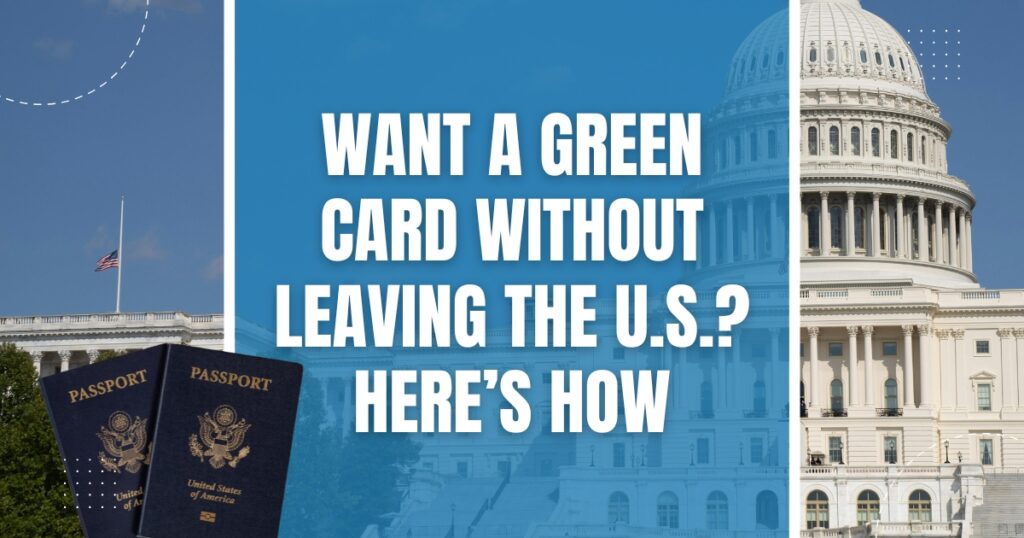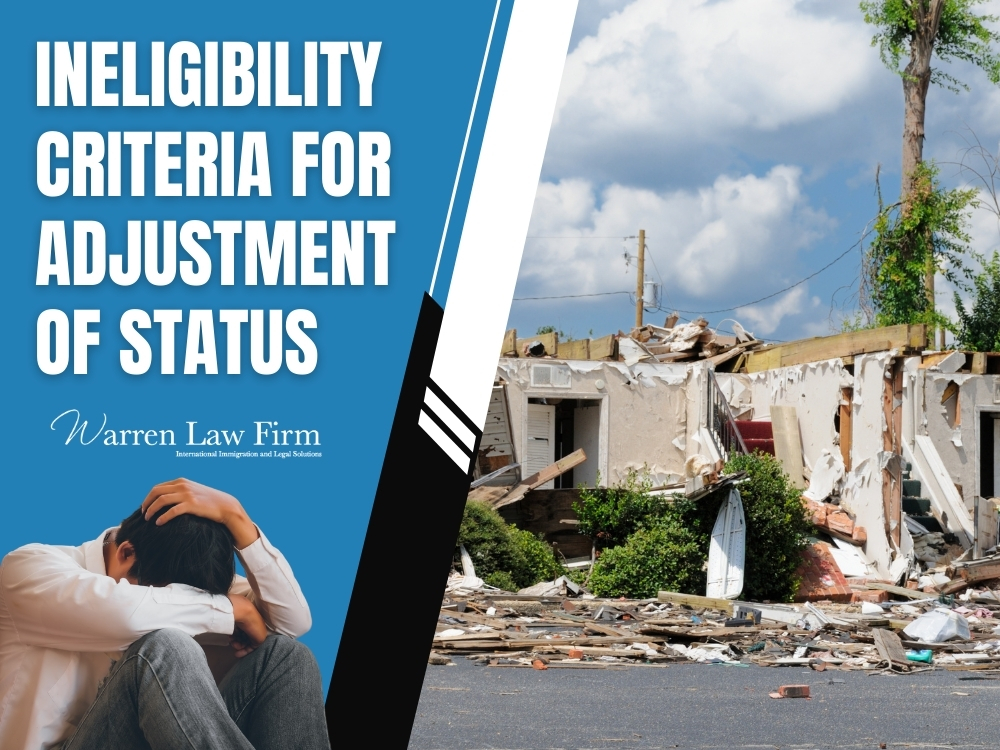Adjustment of Status Guide
Home » Immigration Services » Adjustment of Status Guide
If you are in the U.S. on a temporary visa, you can obtain a green card by applying for adjustment of status. It eliminates the need to leave the U.S. while allowing eligible lawful visa holders to become permanent residents.
Learn about the different pathways to obtain a green card through adjustment of status, how you can qualify, and ways to apply.
Table of Contents
Request A Consultation
Meet The Attorney
Angela D. Warren
With more than 20 years of immigration and business immigration experience, Angela Warren has helped hundreds of individuals, families and businesses.
Get The Immigration Help You Deserve
What Does Adjustment of Status Mean?
Adjustment of status is the process which an eligible visa holder in the United States applies to become a lawful permanent resident (green card holder).
It is different from consular processing, where applicants must apply for a green card from their home country.

90-Day Rule
Before filing for adjustment of status, it’s important to understand the “90-day rule.” It applies to individuals in the U.S. on a temporary visa who later decide to apply for permanent residency. If your actions in the first 90 days in the U.S. don’t match your visa’s purpose, U.S. Citizenship and Immigration Services (USCIS) would determine you misled immigration officers.
For instance, entering the U.S. on a tourist visa but planning to get married and stay permanently might go against the terms of your visa. It’s important to be upfront about your intentions to avoid any legal trouble during your application process.
Get The Immigration Help You Deserve
Who is Eligible for Adjustment of Status?
Before applying for adjustment of status, you must be eligible for a green card.
Here are some of the green card eligibility categories in the U.S.:

Green Card Through Family
You may be able to obtain a green card if you are an immediate relative of a U.S. citizen or lawful permanent resident such as a spouse, a spouse’s child, or a widow(er).
Officials will also consider applications from victims of battery or extreme cruelty by relatives who are U.S. citizens or lawful permanent residents.
Green Card Through Employment
Immigrant workers may also apply for green card status. “First preference” workers are those with extraordinary talents in the arts, sciences, education, business, or athletics as well as professors, researchers, or senior business figures.
Second-preference workers are those with advanced degrees and evidence of exceptional abilities, while third-preference workers are those with substantial skills and experience.
Green Card As A Special Immigrant
You can also obtain a green card as a special immigrant.
USCIS provides these to religious workers, certain Iraq Afghanistan nations, international broadcasters, or employees of various international organizations, including NATO.
Green Card through Other Categories
Finally, there are some other minor categories of individuals who are eligible for green cards.
- Green Card through Registry
- Green Card for Abuse Victims
- Green Card for Human Trafficking and Crime Victims
- Green Card through Refugee or Asylee Status
- Some American Indians born in Canada.
Get The Immigration Help You Deserve
Who is Not Eligible for Adjustment of Status?
Some groups are not eligible for adjustment of status. These include those on:
- Temporary protected status (TPS)
- Deferred enforced departure (DED)
Officials reserve these statuses for individuals fleeing natural disasters in their home countries.

How To Apply For Adjustment Of Status
Overwhelmed by paperwork and convoluted steps? Don’t worry – we got you covered! We’ll be exploring all the details that go into applying for adjustment of status so that you can make informed decisions about taking on this important step in your immigration journey.
Step 1: Complete the required forms
Depending on your status and circumstances, you need to complete various forms to apply for adjustment of status and to obtain a green card.
Forms you may need to complete include:
- Form I-485 – Application to Register Permanent Residence or Adjust Status
- Form I-130 – Petition for Alien Relative (for those applying for a new status based on a family relationship)
- Form I-765 – Application for Employment Authorization (for those requiring a work permit)
- Form I-134 – Affidavit Of Support (for those who do not have a qualifying relative who can offer financial support)
Your attorney will tell you which forms you need, based on your status. You may need to pay various filing fees, depending on the forms you need to file. USCIS lists prices on its website, or you can ask us directly what you need to do.
Step 2: File your Adjustment of Status forms
The next step is filing. Where you file your application depends on your location. You can find filing addresses on the USCIS website or from us.
Step 3: Interview
After filing your application, USCIS will schedule an interview with you. Officials will ask you about your application and require you to provide supporting evidence.
Extra adjustment of status requirements could include:
- Completing a medical examination
- Providing officials with fingerprints or other biometrics
- Giving evidence of financial support, either independently or through a qualifying relative
Any additional documentation the USCIS requests depends on your status and circumstances. Immigration attorneys can advise you on what to provide before you begin your application.
Step 4: USCIS Makes a Decision on Your Application
If the USCIS grants your application, you will gain permanent residency and a green card. This document gives you the right to remain in the country for as long as you wish. You can work, travel, and move freely. If they deny it, you may need to leave the country before your visa runs out or apply for a different type of visa.
How To Expedite Adjustment Of Status
Acquiring permanent residency and a green card can take a long time. However, you can speed up the process by:
- Filing forms as soon as possible
- Submitting your application early when you have plenty of time to spare on your temporary visa
- Paying any expediting fees well in advance
Working with a lawyer will ensure all evidence and forms you submit are completed accurately and correctly. If there are any mistakes in your application, you risk a delay in your processing or even a denial.
Adjustment Of Status Checklist
- Contact an immigration attorney to assist with your application
- Determine adjustment of status eligibility
- Submit forms I-485, I-130, I-765, and I-134 and complete your adjustment of status application. As part of this process, you must:
- Demonstrate lawful status in the U.S. (by showing an existing, in-date temporary visa)
- Prove your relationship with your sponsor (if you need one)
- Submit to a medical examination (if required)
- Provide biometrics to USCIS officials (if required)
- Pay the document processing fees
- Wait for USCIS officials to accept or deny your application
Get The Immigration Help You Deserve
Adjustment of Status FAQs
Can I Be Eligible for Adjustment of Status After Marriage?
If you’re planning to file for adjustment of status after marriage with a U.S. citizen, several requirements must be met. First, you must be physically present in the United States and have entered the country legally, meaning through inspection and admission at a port of entry. Additionally, you must be married to a U.S. citizen or lawful permanent resident in a bona fide, or genuine, marriage.
If you entered the U.S. on a K-1 fiancé(e) visa, you are required to have married the U.S. citizen petitioner within 90 days of your arrival. Finally, you must not be subject to any grounds of inadmissibility to be eligible for adjustment of status after marriage.
How Long Do I Wait for Adjustment of Status After Marriage?
The processing time for adjustment of status after marriage may depend on factors like your local USCIS office’s workload. The application process can take 10-13 months from the date of filing Form I-485 until you receive your green card. For K-1 visa holders, it’s important to remember that you must marry your U.S. citizen petitioner within 90 days of entry to remain eligible for adjustment of status.
You may experience delays due to requests for evidence (RFE) from USCIS or other case-specific issues that may occur. Consider consulting an immigration attorney to guide you through the process or explore USCIS resources for accurate, up-to-date information.
What happens if the USCIS denies my green card application?
Green card denial seems like the end of the road. However, it is not always the case. Working with an immigration lawyer can help you find out the reason for the rejection, including errors made by the USCIS. In some cases, you may be able to file a motion or an appeal after a denial. An experienced immigration can tell you if you’re eligible.
How many green card applications are approved?
The USCIS approves approximately 88 percent of green card applications. However, it denies a significant fraction, meaning it is critical to work with an experienced immigration attorney.
What should I do if I am considering adjusting my status?
If you are considering adjusting your status, you should speak with an immigration attorney. They will tell you if you are eligible and how you should apply to maximize your chances of success.
How Do I Apply for Adjustment of Status After Getting Married?
If you’re applying for adjustment of status 90 days after marrying your U.S. citizen spouse, the first step is to complete and submit Form I-485. Gather all necessary documents, such as proof of your marriage, lawful entry into the U.S., and evidence of a bona fide relationship.
While your application is pending, you can apply for work authorization and travel permit by filing Form I-765 and Form I-131, respectively. Once you filed your application, USCIS will schedule a biometrics appointment for them to collect your fingerprints, photographs, and signatures.
Most applicants will also need to attend an interview. A USCIS officer will ask questions about your relationship, background, and eligibility for your green card. Finally, USCIS will notify you of their decision, and if approved, they will send your green card to you by mail.
Get The Immigration Help You Deserve
Talk to an Adjustment of Status Lawyer About Permanent Residency
Eligible immigrants can apply for a green card in the U.S., whether it’s after marriage, employment, or through other categories. If you have questions or need legal advice for your adjustment of status application, our immigration attorneys from Warren Law are here to help.
Schedule a consultation with us today! We have the experience to guide you with any immigration concern, including the adjustment of status process.
